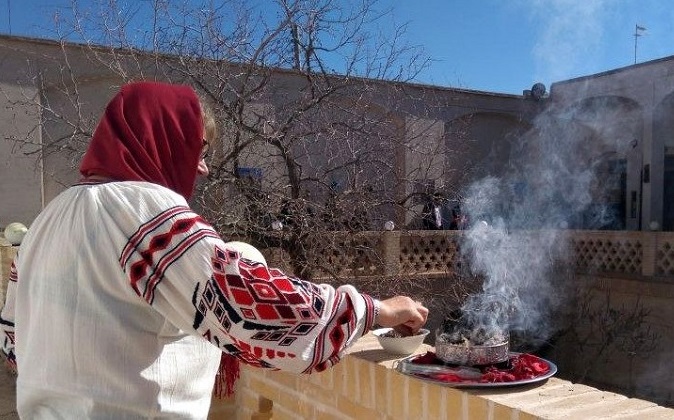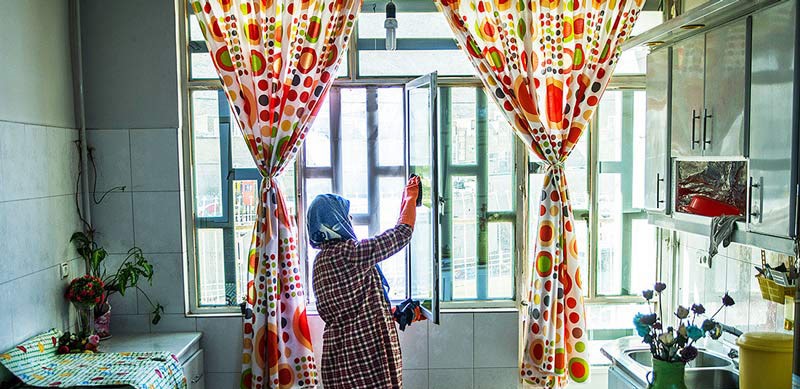NOWRUZ; A CELEBRATION OF LIFE IN IRAN

Nowruz as the most splendid, popular, and ancient Iranian festival is deeply rooted in
Zoroastrianism. Iranians celebrate New Year with revival of nature from wintertime. Ancientness,
colorfulness, and affluent symbolism of Nowruz are comparable to other countries and nations’
beliefs and customs.
Nowruz is the Celebration of Life which is determined according to the spring equinox and
coincided with March 21 as the beginning of the spring in the northern hemisphere.
Haji-Firuz, Herald of Nowruz, as the
tambourine man in red and with black painted
face goes to all cities and villages while
dancing and singing happy and vernal songs
and gives glad tidings to young and old.

Esfand, as the last month of Persian year is the golden
chance for welcoming preparations in which Iranian
matrons and housekeepers begin to spring cleaning
(Khaneh- Takani, in Persian). It consists of washing, cleaning and also dusting off carpets and furniture and re-setting them. Planting seeds of wheat,
lentil, or barley in pots, two or three weeks before Nowruz eve, is a beautiful and wonderful custom
of this festival in the name of planting Sabzeh. It can be said that nowadays people buy Sabzeh
from florist’s shops. Kharid-E-Nowruz (Nowruz shopping) is one of the most exciting customs of
welcoming Nowruz eve. It consists of purchasing new garments, sweets, Flowers such as hyacinths
and tulips and Haft-Seen table (Sofreye Haft-Seen). SEVEN is a sacred number in Persian Mythology. According
to beliefs, seven levels of earth and heaven, seven Gods and
seven constellations control seven days of a week and mortal
fate.

There are seven other items which are placed on the haft-seen table, although their names don’t
began with voice of (S) in Farsi language as follow:
The Quran, a mirror, two candles, painted eggs (as like as eggs of Easter), a bowl of water with an
orange floating in it, one, two or three Golf fish swinging in a crystal cup, confections, a variety
of fruits, kolucheh (a traditional biscuit), Iranian traditional sweets such as Baghlava (a kind of
pastry), Ajeel (dried nut and seeds) such as pistachio, almond, Hazel-nut, dried fig, mulberry,
raisin, etc.. The items mentioned above are other important parts of Nowruz festival which repeat
the variety of colors in Iranian table.
Nowruz has its own particular meals such as SabziPolo-Mahi (rice with green herbs and fish) which
will be cooked and served at the night preceding or
first day of Nowruz eve. Reshteh Polo, rice cooked
with noodles, will be served on the next day while
Koku Sabzi (herbs and vegetable soufflé) served as
the dinner. Polo (cooked rice) and chicken will be
served at Friday night prior to Nowruz.
Nowruz will be begun with Tahvil-E-Saal ceremony which can be translated as delivery of a year.
Incipient moment of new Iranian year is coincided with spring equinox.
At the moment of Tahvil-E-Saal (delivery of a
year), all members of a family dress up and gather
together around Hasft- Seen table while they are
looking forward to come about the moment of
Tahvil-E-Saal. At the glamouros and dreamy
moment of Tahvil-E-Saal all the members of a
family embrace, kiss and congratulate each other on
New Year and Nowruz eve. Everyone has a set schedule of visits and receiving visitors during
Nowruz holidays. It is customary for the young call on the elder in order to respect them, on the
basis of Persians beliefs and customs.
EIDI, the New Year gift, is another special characteristic of Nowruz. It is duty of elders who offer
Eidi to members of their family and also hosts offer Eidi to guests’ children. The period of
visitations may be 12 days or until 13th day which is called SIZDAH-BE-DAR.
Among all Iranian traditional ceremonies, Nowruz with various characteristics and aspects
perform and celebrate in every region of Iran as well as Persian language countries such as
Afghanistan, Tajikistan, Kazakhstan, Kyrgyzstan Azerbaijan, Turkmenistan Georgia, etc.
Nowruz repeats; renews everything; revives nature and influences Iranian creative soul, emotion
and thought.
Haft-Seen as the integral part of all Iranian households in
Nowruz festival, has seven S-items on the basis of their
Persian names. Its role in Nowruz eve is comparable with
Christmas tree. Zoroastrians used to decorate haft-Seen in
seven big trays containing 7-S-Items in Persian. Nowadays Iranian people decorate haft-seen table
with 7 traditional and/or modern container. Each item introduces a symbol as follow:
1- SABZEH (grass) with a red or orange-colored) ribbon around it, as the symbol of rebirth and
revitalization, is the most eminent item of haft seen table.
2- SEEB (red or yellow apple) as the symbol of beauty and health
3- SAMANOO (a sweet pudding made with wheat germ juice, flour, water, saffron) as the symbol
of wealth.
4- SENJED (Sea-buckthorn) as the symbol of love
5- SEER (Garlic) as the symbol of guardian table
6- SUMAC as the symbol of sunrise
7- SERKEH (Vinegar) as the symbol of patience.

